Design and Properties Analysis of Novel Modified 1-3 Piezoelectric Composite
Abstract
:1. Introduction
2. Materials and Methods
2.1. Design of Modified 1-3 Piezoelectric Composite Structure
2.2. Finite Element Simulation and Model Analysis
2.3. Fabrication and Experiment of Modified 1-3 Piezoelectric Composite
- Cut the sample size. PZT-5A piezoelectric ceramic block (105 mm × 105 mm × 7.5 mm) is cut into a sample with dimensions of 63 mm × 29.5 mm × 3 mm. The ceramic sheet is cut in accordance with the sample size. The cutting blade cuts laterally along the wide side of the ceramic while retaining the ceramic substrate.
- Apply 618 epoxy resin. The cut samples are washed ultrasonically. After wiping and drying, 618 epoxy resin is perfused and cured at room temperature in a dry place for 24 h.
- The second cutting of piezoelectric composite. The surface of the epoxy pouring material is polished and smoothed. The material is placed into the cutting machine again for the second cutting, and the blade cuts longitudinally along the long side of the composite.
- Pour the 704 flexible silicone rubber. The cut ceramics are cleaned through ultrasonic wiping and drying and then poured into the 704 silicone rubber.
- Use cutting blades to grind away excess composite substrates.
- Coat silver electrode. The composite sample is polished and leveled. The upper and lower surfaces of the material are coated with conductive silver slurry so as to prepare the modified 1-3 piezoelectric composite sample.
3. Results and Discussion
3.1. Finite Element Simulation Results of Materials
3.1.1. Properties of 1-3 Type and Modified 1-3 Type Composites
3.1.2. Decoupling Characteristics of Modified 1-3 Type Composite
3.2. Experimental Test Results of the Materials
4. Conclusions
Author Contributions
Funding
Institutional Review Board Statement
Informed Consent Statement
Data Availability Statement
Conflicts of Interest
References
- Satvik, M.K.; Arunkumar, G.; Manjunath, T.C. Development of mathematical model for smart intelligent flexible structures using smart intelligent sensor & actuator materials using Timoshenko beam theory & its control using POF. Mater. Today Proc. 2020, 5, 630–638. [Google Scholar]
- Zaszczyńska, A.; Gradys, A.; Sajkiewicz, P. Progress in the Applications of Smart Piezoelectric Materials for Medical Devices. Polymers 2020, 12, 2754. [Google Scholar] [CrossRef]
- Zhang, F.; Feng, P.; Wang, T.; Chen, J. Mechanical-electric response characteristics of 1-3 cement based piezoelectric composite under impact loading. Constr. Build. Mater. 2019, 228, 116781. [Google Scholar] [CrossRef]
- Li, X.; Wang, L.; Zhong, C.; Zhang, Y. The effect of piezoelectric ceramic volume fraction on the thickness vibration characteristics of 1-3 piezocomposites. Ferroelectrics 2018, 531, 84–91. [Google Scholar] [CrossRef]
- Geng, B.; Xu, D.Y.; Yi, S.L.; Gao, G.P.; Xu, H.C.; Cheng, X. Design and properties 1-3 multi-element piezoelectric compo-site with low crosstalk effects. Ceram Int. 2017, 43, 15167–15172. [Google Scholar] [CrossRef]
- Bian, J.; Wang, Y.; Liu, Z.; Shen, M.; Zhao, H.; Sun, Y.; Zhu, J. Ultra-wideband underwater acoustic transducer with a gradient impedance matching layer. Appl. Acoust. 2021, 175, 107789. [Google Scholar] [CrossRef]
- Sun, R.; Wang, L.; Zhang, Y.; Zhong, C. Characterization of 1-3 Piezoelectric Composite with a 3-Tier Polymer Structure. Materials 2020, 13, 397. [Google Scholar] [CrossRef] [Green Version]
- Luan, G.D.; Zhang, J.D.; Wang, R.Q. Piezoelectric Transducers and Arrays; Beijing University: Beijing, China, 2005; pp. 73–100. [Google Scholar]
- Cross, L.E. Ferroelectric materials for electromechanical transducer applications. Mater. Chem. Phys. 1996, 43, 108–115. [Google Scholar] [CrossRef]
- Zhang, K. The Study of High-frequency Broad-band Piezocomposite Transducers. Ph.D. Thesis, Harbin Engineering University, Harbin, China, 2011. [Google Scholar]
- Gururaja, T.R.; Schulze, W.; Cross, L.E.; Newnham, R.E. Piezoelectric Composite Materials for Ultrasonic Transducer Ap-plications. Part I: Resonant Modes of Vibration of PZT Rod-Polymer Composites. IEEE Trans. Sonics Ultrason. 1985, 32, 481–498. [Google Scholar] [CrossRef] [Green Version]
- Fujishima, S. The history of ceramic filters. IEEE Trans. Ultrason. Ferroelectr. Freq. Control 2000, 47, 1–7. [Google Scholar] [CrossRef] [Green Version]
- Zhong, C. Research on Three-Phase Piezocomposite and Curved Surface Transducer. Ph.D. Thesis, Beijing University of Posts and Telecommunications, Beijing, China, 2019. [Google Scholar]
- Furukawa, T.; Ishida, K.; Fukada, E. Piezoelectric properties in the composite systems of polymers and PZT ceramics. J. Appl. Phys. 1979, 50, 4904–4912. [Google Scholar] [CrossRef]
- Jaffe, B.; Roth, R.S.; Marzullo, S. Piezoelectric Properties of Lead Zirconate-Lead Titanate Solid-Solution Ceramics. J. Appl. Phys. 1954, 25, 809–810. [Google Scholar] [CrossRef]
- Kimura, T. Application of Texture Engineering to Piezoelectric Ceramics. J. Ceram. Soc. Jpn. 2006, 114, 15–25. [Google Scholar] [CrossRef] [Green Version]
- Li, G.; Wang, L.K.; Luan, G.D.; Zhang, J.D.; Li, S.X. A study of a 1-3-2 type piezoelectric composite. Ultrasonics 2006, 44, 639–642. [Google Scholar]
- Xu, L.F. Study on Fabrication, Structure and Properties of PZTS/Epoxy Resin 1-3 Composites. Ph.D. Thesis, Wuhan University of Technology, Wuhan, China, 2006. [Google Scholar]
- Kim, C.; Rittenmyer, K.M.; Kahn, M. 1-1-3 Piezocomposite for hydrophone transducer. Ferroelectrics 1994, 156, 19–24. [Google Scholar] [CrossRef]
- Zhang, Q.M.; Cao, W.; Wang, H.; Cross, L.E. Characterization of the performance of 1–3 type piezocomposites for low-frequency applications. J. Appl. Phys. 1993, 73, 1403–1410. [Google Scholar] [CrossRef] [Green Version]
- Hao, S.; Wang, H.; Zhong, C.; Wang, L.; Zhang, H. Research and Fabrication of High-Frequency Broadband and Omnidirec-tional Transmitting Transducer. Sensors 2018, 18, 2347. [Google Scholar] [CrossRef] [Green Version]
- Wang, J.; Chen, M.; Zhao, X.; Wang, F.; Tang, Y.; Lin, D.; Luo, H. Fabrication and high acoustic performance of high frequency needle ultrasound transducer with PMN-PT/Epoxy 1-3 piezoelectric composite prepared by dice and fill method. Sens. Actuators A Phys. 2021, 318, 112528. [Google Scholar] [CrossRef]
- Kim, B.S.; Ji, J.H.; Koh, J.H. Improved strain and transduction values of low-temperature sintered CuO-doped PZT-PZNN soft piezoelectric materials for energy harvester applications. Ceram Int. 2021, 47, 6683–6690. [Google Scholar] [CrossRef]
- Kothari, A.; Kumar, A.; Kumar, R.; Vaish, R.; Chauhan, V.S. A study on epoxy-based 1-3 piezoelectric composites using finite element method. Polym. Compos. 2015, 37, 1895–1905. [Google Scholar] [CrossRef]
- Benard, O.P.; Shaalan, N.M.; Koichi, N.; Mahmoud, A.E.; Hassan, M.A. Numerical Modeling of PZT- Piezoelectric Compo-sites with Passive and Active Polymer Matrix. Key Eng. Mater. 2019, 821, 445–451. [Google Scholar] [CrossRef]
- Li, L. Research on 1-3 Series Piezoelectric Composite and Underwater Transducer. Ph.D. Thesis, Beijing University of Posts and Telecommunications, Beijing, China, 2008. [Google Scholar]
- Newnham, R.; Skinner, D.; Cross, L. Connectivity and piezoelectric-pyroelectric composites. Mater. Res. Bull. 1978, 13, 525–536. [Google Scholar] [CrossRef]
- Liu, X.; Wang, L.; Zhong, C.; Zhang, Y.; Hao, S.; Sun, R. Piezoelectric Composite Vibrator with a Bilaminated Structure for Bending Vibration. Appl. Sci. 2019, 9, 4191. [Google Scholar] [CrossRef] [Green Version]
- Liu, D.K. Study on Fabrication and Physical Properties of 1-3 Piezoelectric Composites. Ph.D. Thesis, Shandong University, Jinan, China, 2019. [Google Scholar]
- Mi, X.H.; Qin, L.; Liao, Q.W.; Wang, L.K. Electromechanical coupling coefficient and acoustic impedance of 1-1-3 piezoelectric composites. Ceram Int. 2017, 43, 7374–7377. [Google Scholar] [CrossRef]
- Lee, H.J.; Zhang, S.; Meyer, R.J., Jr.; Sherlock, N.P.; Shrout, T.R. Characterization of piezoelectric ceramics and 1-3 composites for high power transducers. Appl. Phys. Lett. 2012, 101, 32902. [Google Scholar] [CrossRef]
- Lusiola, T.; Oberle, S.; Gorjan, L.; Clemens, F. Effect of Polymer-Ceramic Fibre Interphase Design on Coupling Factor in Low Fibre Volume Content Piezoelectric Composites. Adv. Mater. Sci. Eng. 2018, 2018, 1–8. [Google Scholar] [CrossRef] [Green Version]
- Zhu, J.; Wang, Z.; Zhu, X.; Yang, B.; Fu, C. Theoretical and Experimental Study on the Effective Piezoelectric Properties of 1-3 Type Cement-Based Piezoelectric Composites. Materials 2018, 11, 1698. [Google Scholar] [CrossRef]
- Wang, C.; Zhang, R.; Jing, Y.; Cao, W. The effect of polymeric filler on poling behavior and thermal stability of 1-3 piezoelectric composites. J. Phys. D Appl. Phys. 2016, 49, 025301. [Google Scholar] [CrossRef]
- Li, N. Study on Preparation and Physical Properties of 1-3 Piezoelectric Composites. Master’s Thesis, Shandong University, Jinan, China, 2019. [Google Scholar]
- Klicker, K.A.; Biggers, J.V.; Newnham, R.E. Composites of PZT and Epoxy for Hydrostatic Transducer Applications. J. Am. Ceram. Soc. 1981, 64, 5–9. [Google Scholar] [CrossRef]
- Tressler, J.; Alkoy, S.; Dogan, A.; Newnham, R. Functional composites for sensors, actuators and transducers. Compos. Part A Appl. Sci. Manuf. 1999, 30, 477–482. [Google Scholar] [CrossRef]
- Xie, M.X. Finite Element Analysis of 1-3 Piezocomposites are Used for Medical Ultrasonic Transducers. Master’s Thesis, Shaanxi Normal University, Xi’an, China, 2006. [Google Scholar]
- Wang, D.; Fan, Z.; Rao, G.; Wang, G.; Liu, Y.; Yuan, C.; Ma, T.; Li, D.; Tan, X.; Lu, Z.; et al. Ultrahigh piezoelectricity in lead-free piezoceramics by synergistic design. Nano Energy 2020, 76, 104944. [Google Scholar] [CrossRef]
- Habib, M.; Lee, M.H.; Kim, D.; Choi, H.I.; Kim, M.H.; Kim, W.J.; Song, T.K. Phase evolution and origin of the high piezo-electric properties in lead-free BiFeO3-BaTiO3 ceramics. Ceram Int. 2020, 46, 22239–22252. [Google Scholar] [CrossRef]
- Ke, Q.; Liew, W.H.; Tao, H.; Wu, J.; Yao, K. KNNS-BNZH Lead-Free 1–3 Piezoelectric Composite for Ultrasonic and Photoacoustic Imaging. IEEE Trans. Ultrason. Ferroelectr. Freq. Control. 2019, 66, 1395–1401. [Google Scholar] [CrossRef]
- Wang, L.K.; Li, S.X.; Qin, L.; Du, H.L.; Li, L. Single Crystal PMNT/Polymer 1-3-2 Piezoelectric Composites. Solid State Phenom. 2007, 124–126, 1103–1107. [Google Scholar] [CrossRef]
- He, C.; Wang, Y.; Lu, Y.; Liu, Y.; Wu, B. Design and Fabrication of Air-Based 1-3 Piezoelectric Composite Transducer for Air-Coupled Ultrasonic Applications. J. Sens. 2016, 2016, 1–11. [Google Scholar] [CrossRef]
- Rouffaud, R.; Levassort, F.; Thi, M.P.; Bantignies, C.; Lethiecq, M.; Hladky-Hennion, A.C. Super-Cell Piezoelectric Compo-site with 1-3 Connectivity. IEEE Trans. Ultrason. Ferr. 2016, 63, 2215–2223. [Google Scholar] [CrossRef]
- Zhong, C.; Wang, L.-K.; Qin, L.; Yu, B.-W. Novel piezoelectric composite spherical cap broadband transducer. Ferroelectrics 2018, 524, 195–200. [Google Scholar] [CrossRef]
- Zhang, Y.; Wang, L.; Qin, L.; Liao, Q.; Zhong, C. A Doubly-Curved Piezoelectric Composite with 1–3 Connectivity for Underwater Transducer Applications; IOP Publishing: Shanghai, China, 2018; Volume 317, p. 012041. [Google Scholar]
- Li, F.; Chen, C.; Li, W.; Zeng, D. The electro-acoustic output behavior and thermal stability of 1–3 piezoelectric composite transducers applied to FUS surgery. J. Mater. Sci. Mater. Electron. 2020, 31, 12066–12073. [Google Scholar] [CrossRef]
- Benjamin, K.C. Recent Advances in 1-3 Piezoelectric Polymer Composite Transducer Technology for AUV/UUV Acoustic Imaging Applications. J. Electroceramics 2002, 8, 145–154. [Google Scholar] [CrossRef]
- Zhong, C.; Wang, L.; Qin, L.; Zhang, Y. Characterization of an improved 1-3 piezoelectric composite by simulation and ex-periment. J. Appl. Biomater. Funct. Mater. 2017, 15, e38–e44. [Google Scholar]
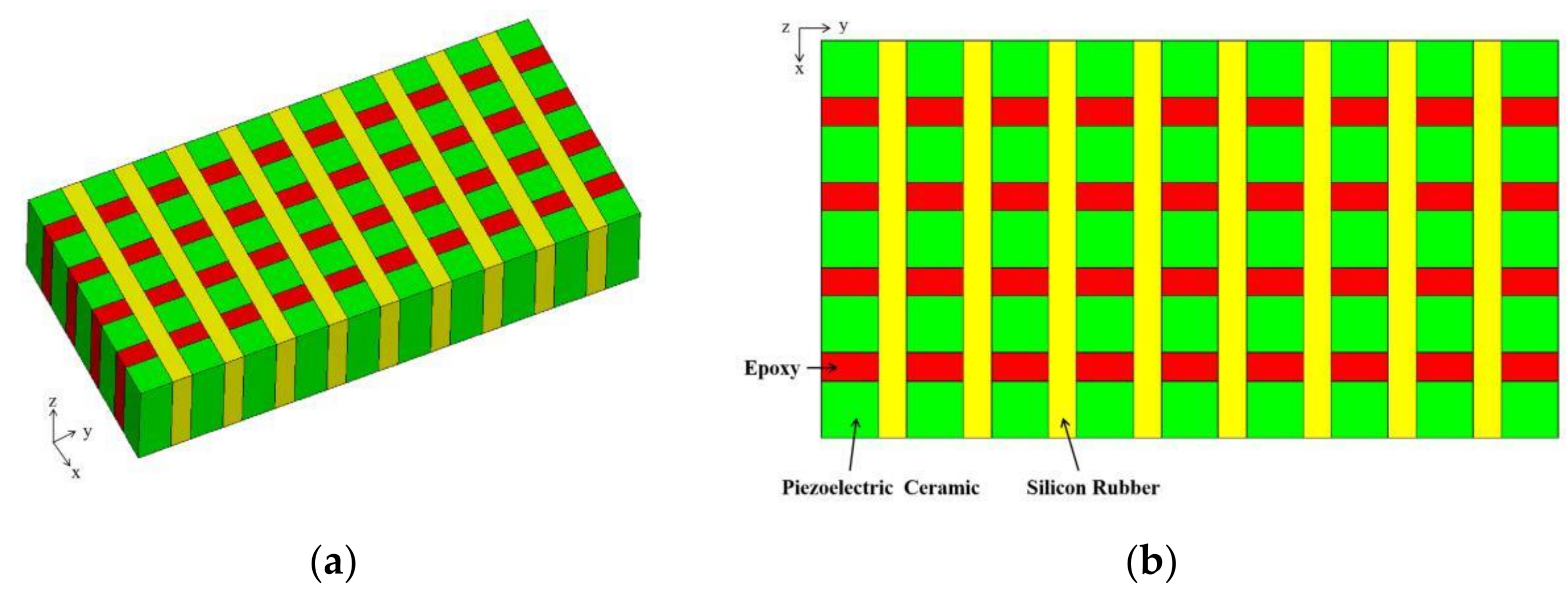

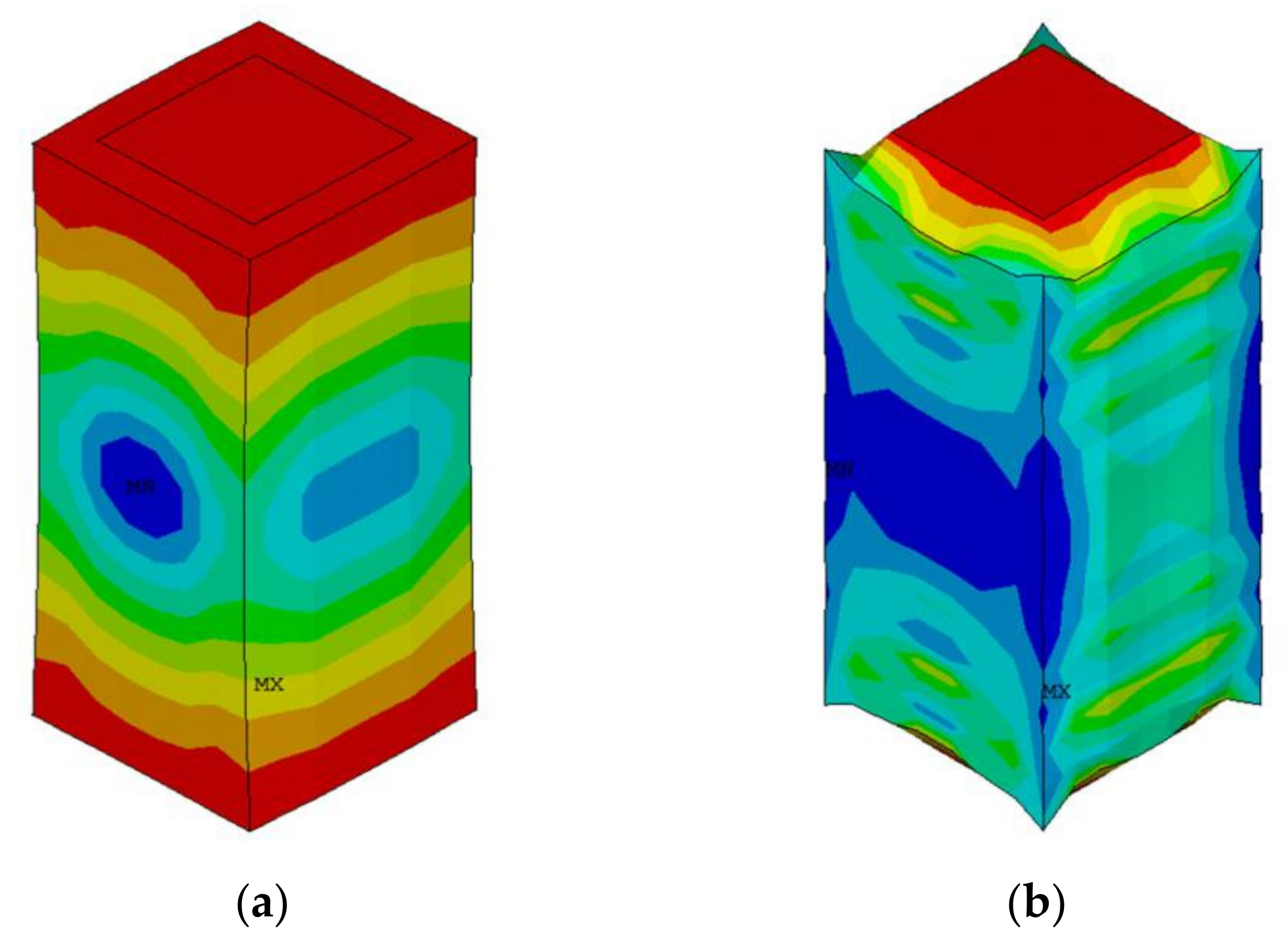
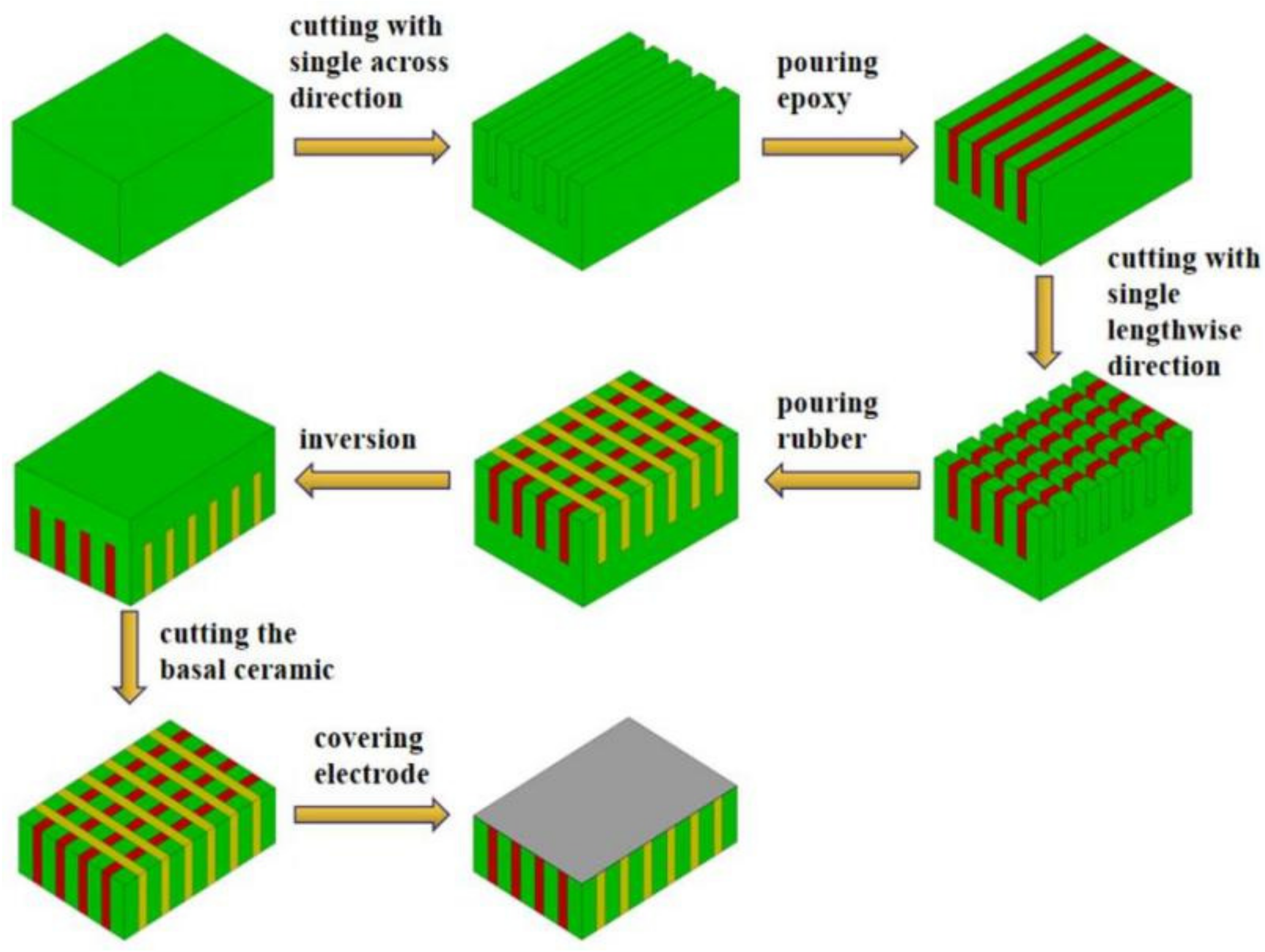
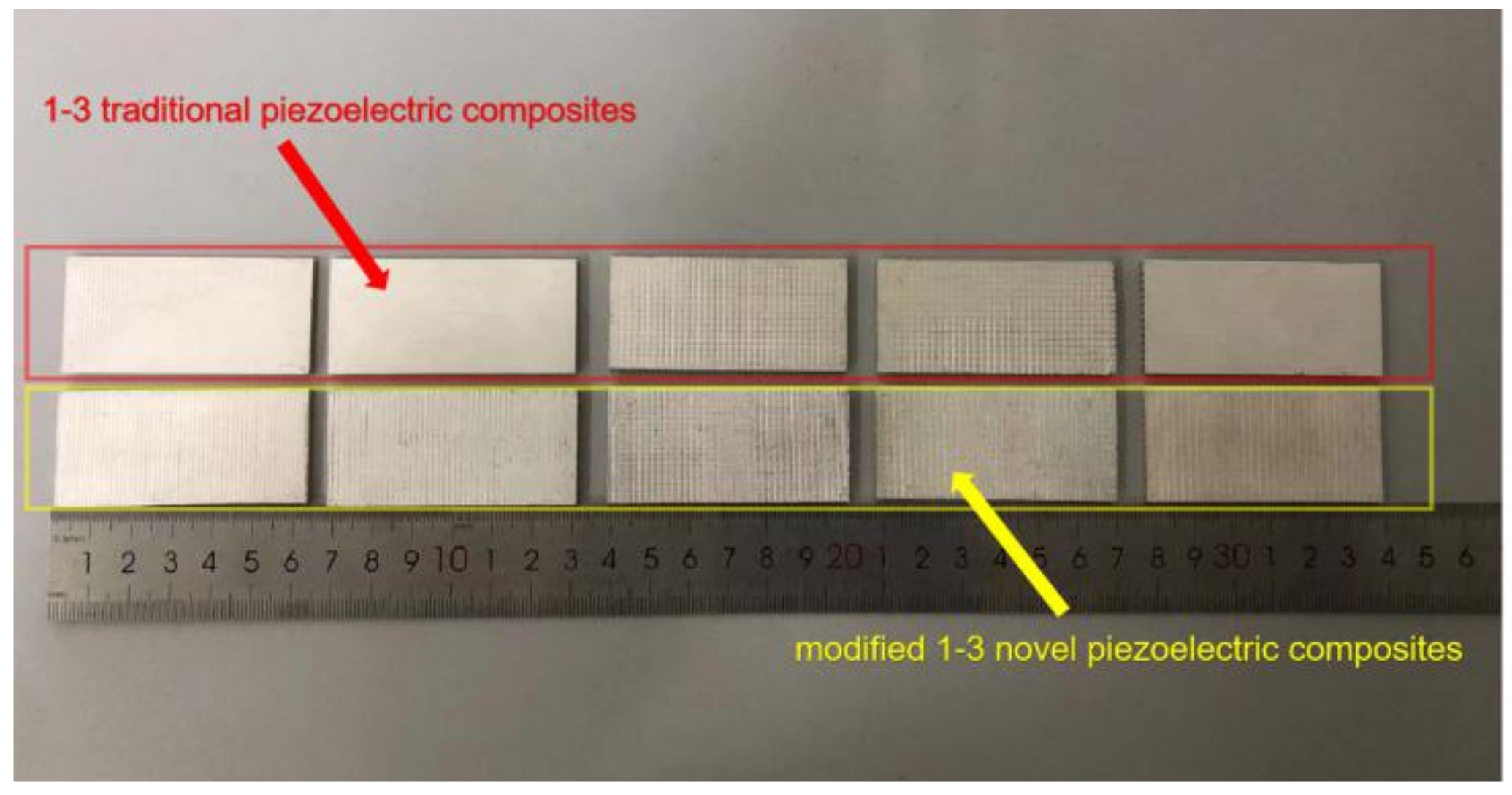

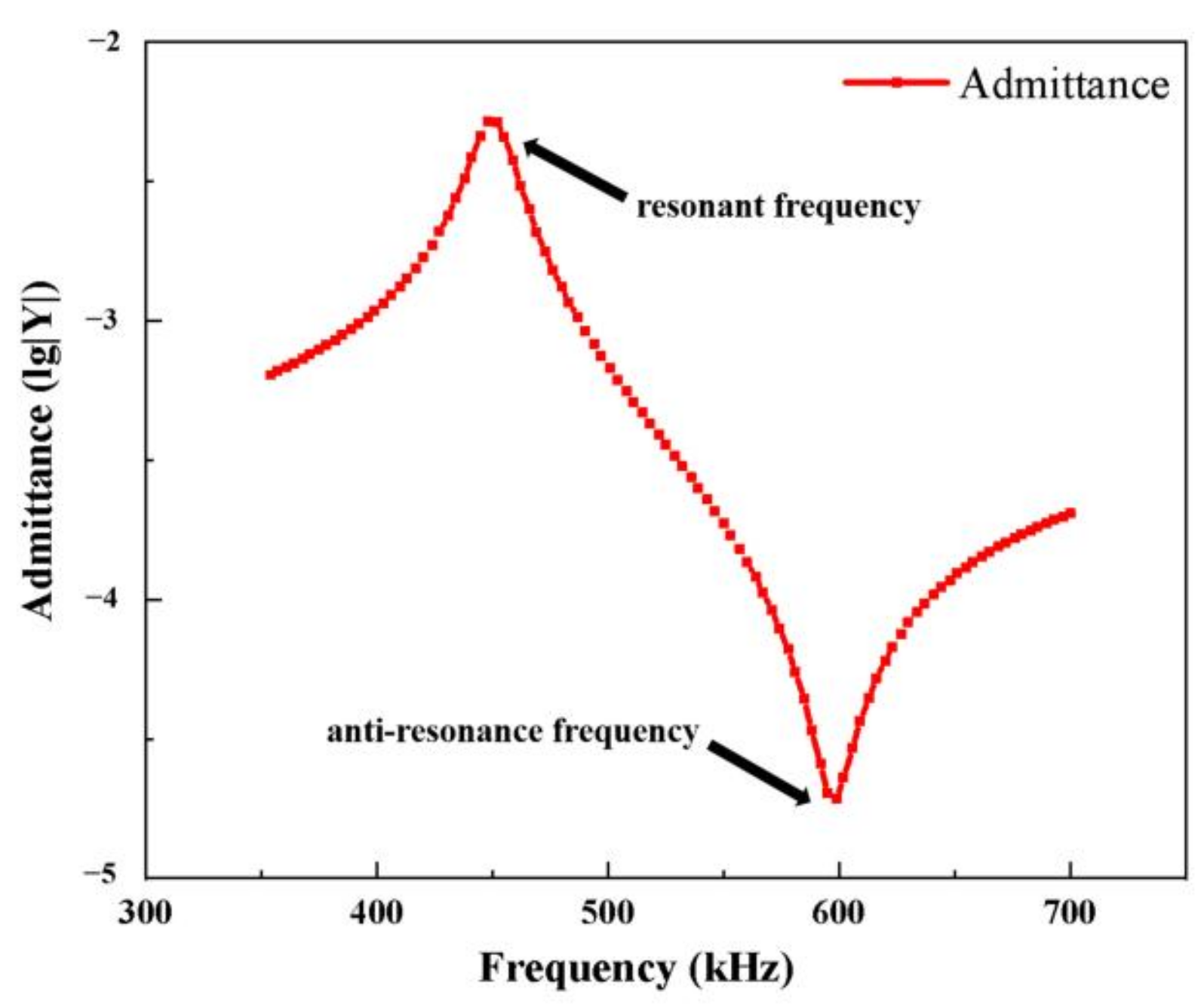
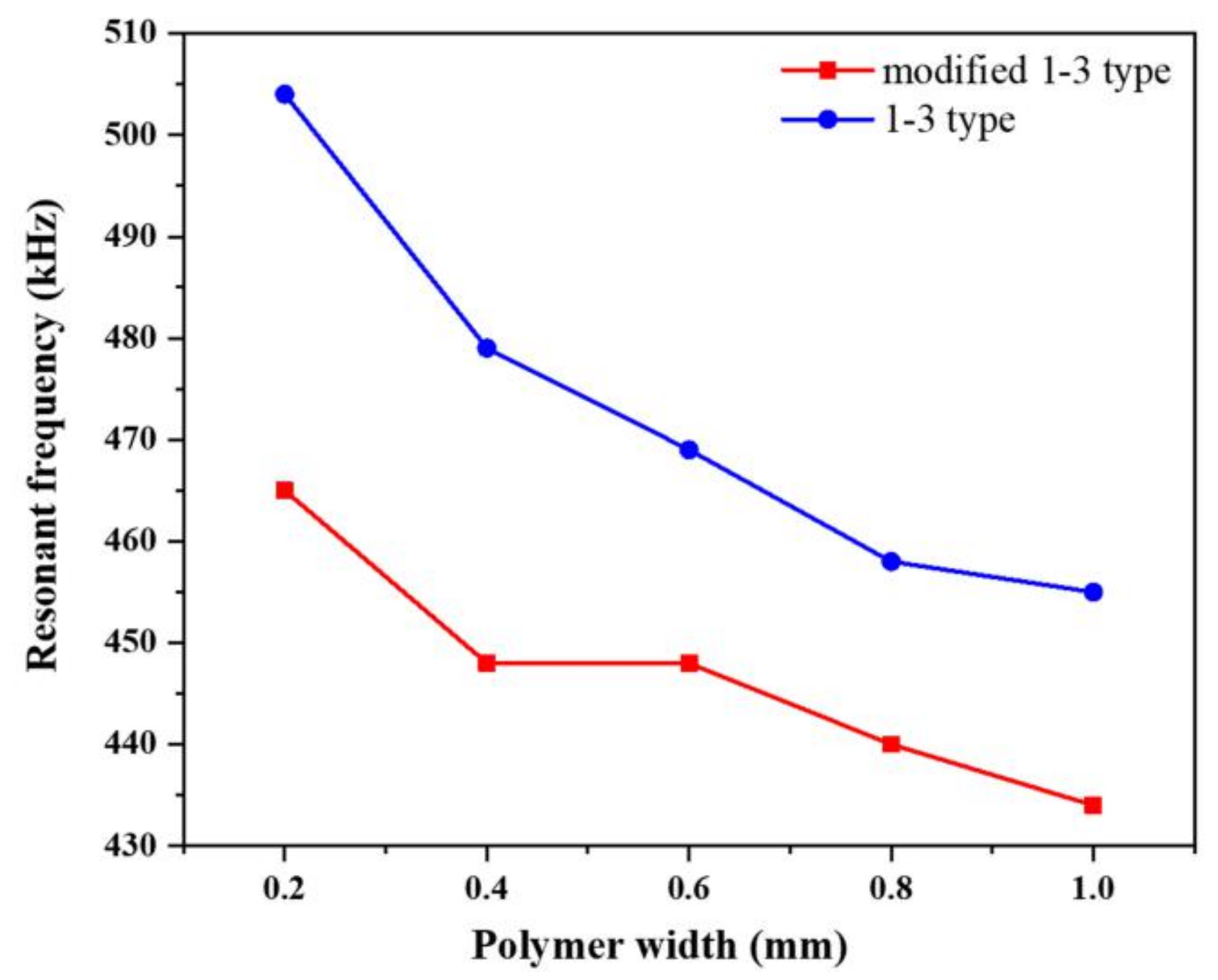
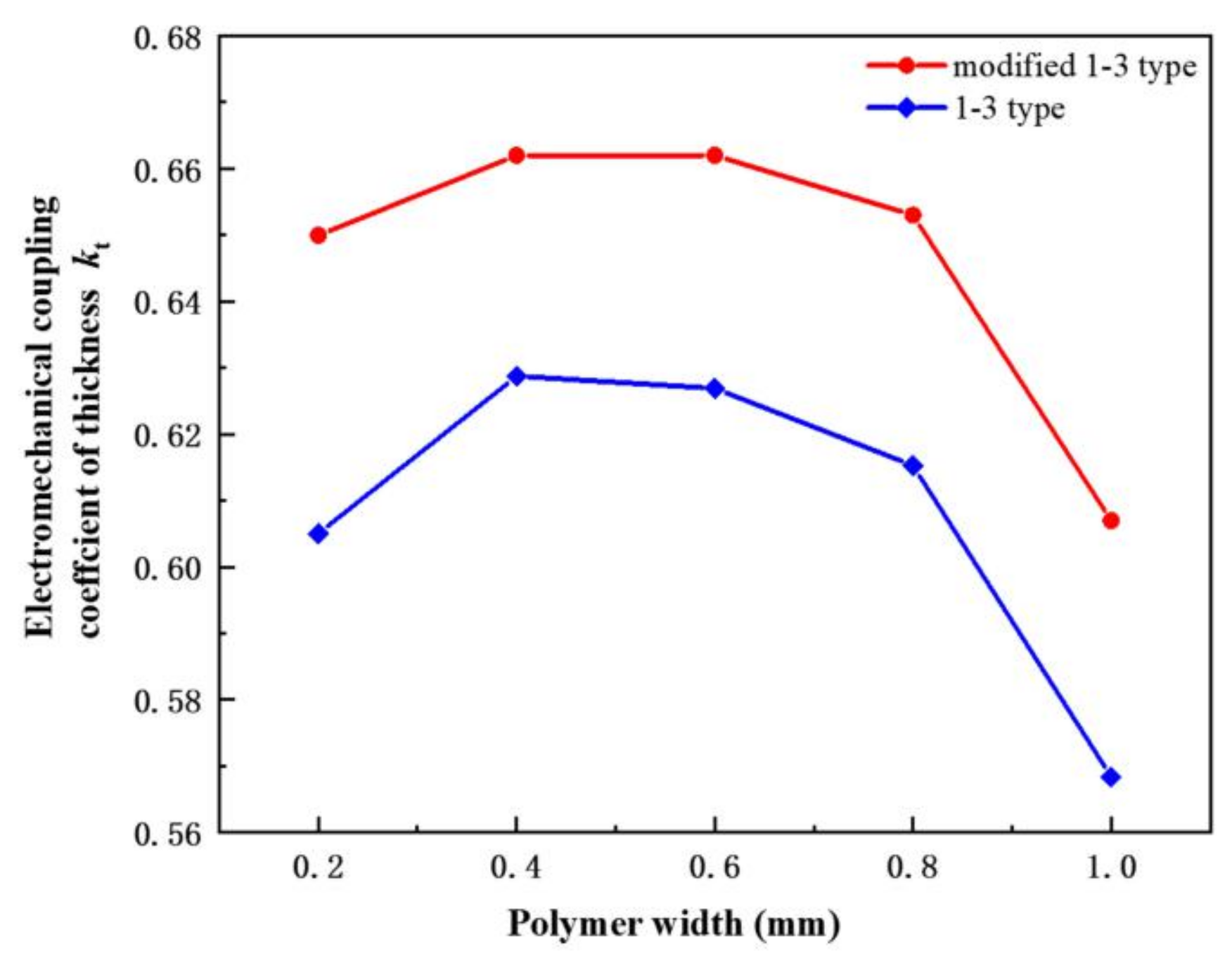
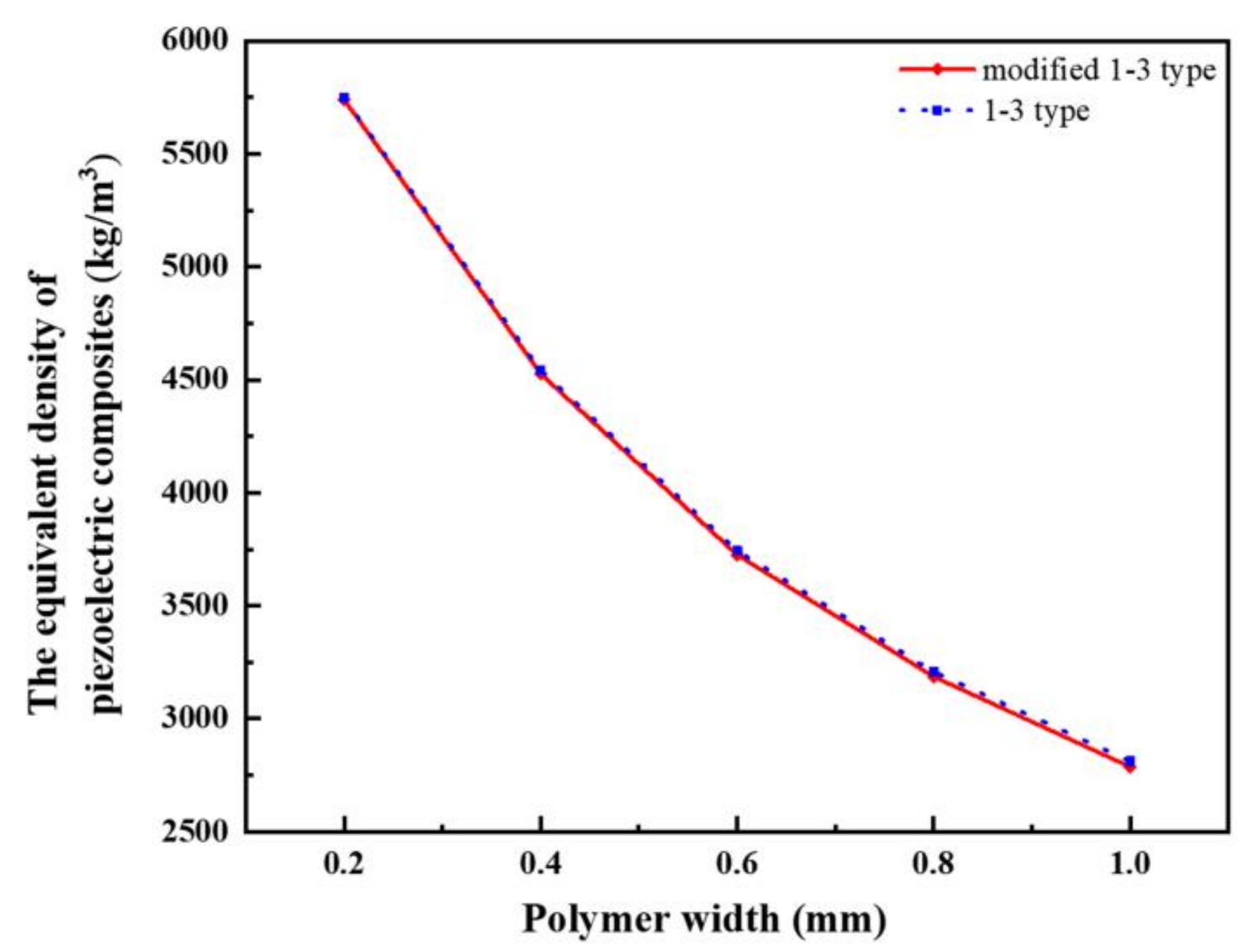





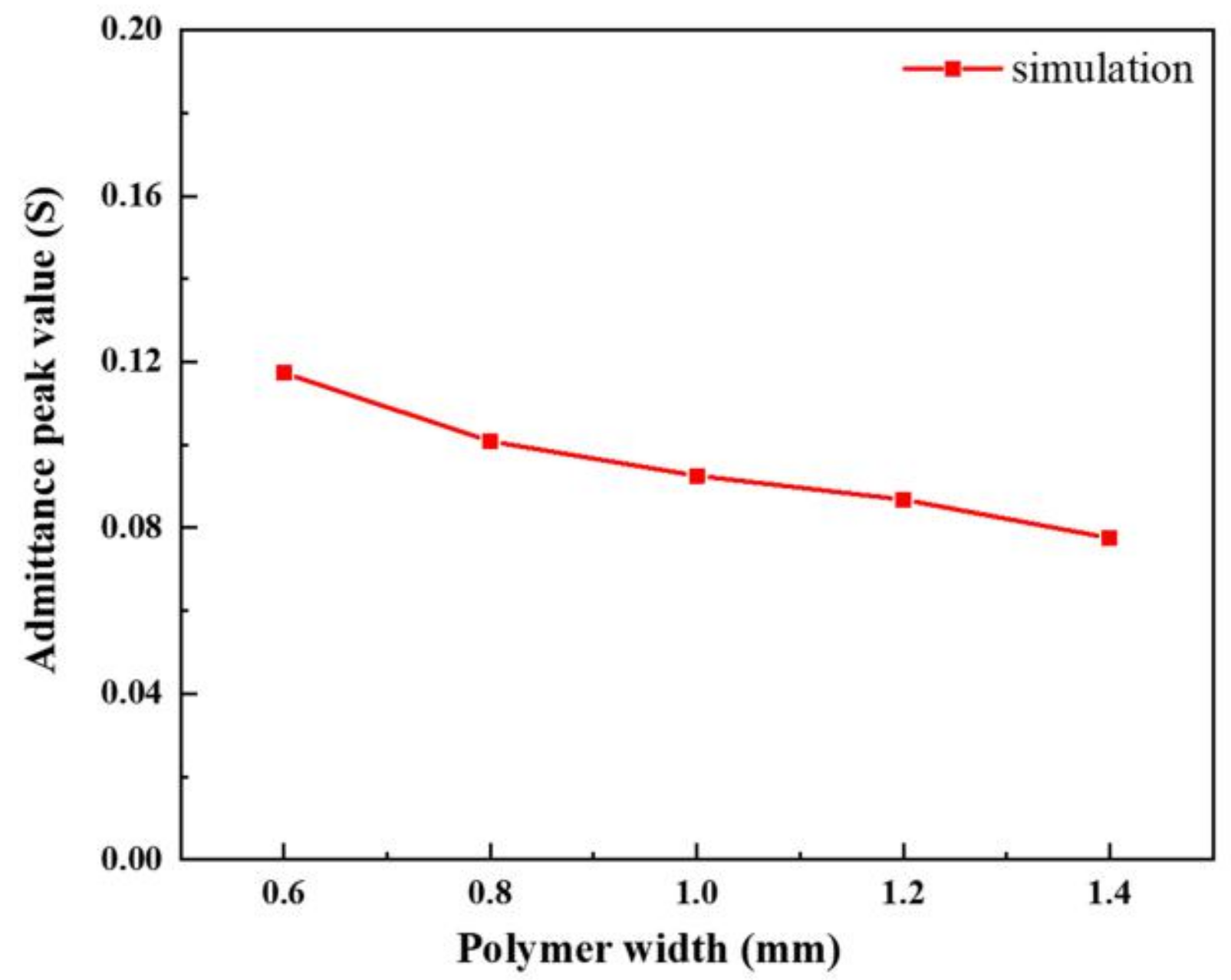



| Parameter | PZT-5A | Epoxy | Silicon Rubber |
|---|---|---|---|
| ρ (kg/m3) | 7750 | 1050 | 1000 |
| cE11(1010 N/m2) | 12.1 | 0.36 | 0.004 |
| cE12(1010 N/m2) | 7.54 | 0.138 | 0.0023 |
| cE13(1010 N/m2) | 7.52 | 278 | 4 × 105 |
| cE33(1010 N/m2) | 11.1 | −97 | 2.3 × 105 |
| sE11(10−12 m2/N) | 16.4 | 278 | 4 × 105 |
| sE12(10−12 m2/N) | −5.74 | −97 | 2.3 × 105 |
| sE13(10−12 m2/N) | −7.22 | / | / |
| sE33(10−12 m2/N) | 18.8 | / | / |
| e31 | −5.4 | / | / |
| e33 | 15.8 | / | / |
| εS33/ε0 | / | 4 | 3.3 |
| εT33/ε0 | / | 4 | 3.3 |
| Polymer Width (mm) | Ceramic Volume | Epoxy Volume | Rubber Volume |
|---|---|---|---|
| 0.2 | 0.701 | 0.135 | 0.164 |
| 0.4 | 0.521 | 0.198 | 0.281 |
| 0.6 | 0.402 | 0.229 | 0.369 |
| 0.8 | 0.322 | 0.242 | 0.437 |
| 1.0 | 0.263 | 0.245 | 0.492 |
| Rubber Width Properties | Resonant Frequency fs (kHz) | Electromechanical Coupling Coefficient of Thickness kt | Maximum Admittance Modulus (S) |
|---|---|---|---|
| 0.6 | 448 | 0.662 | 0.117 |
| 0.8 | 448 | 0.658 | 0.101 |
| 1.0 | 444 | 0.660 | 0.093 |
| 1.2 | 444 | 0.660 | 0.087 |
| 1.4 | 444 | 0.660 | 0.078 |
| Materials Type | Polymer Width (mm) | Resonant Frequency (kHz) | Anti-Resonance Frequency (kHz) | Electromechanical Coupling Coefficient of Thickness | Characteristic Impedance (Mrayls) | −3 dB Bandwidth (kHz) |
|---|---|---|---|---|---|---|
| 1-3 type | 0.2 | 527.5 | 677.5 | 0.628 | 23.36 | 7.01 |
| 0.4 | 505 | 650 | 0.630 | 17.71 | 11.70 | |
| 0.6 | 497.5 | 640 | 0.629 | 14.37 | 11.03 | |
| 0.8 | 490 | 627.5 | 0.635 | 12.08 | 13.28 | |
| 1.0 | 495 | 612 | 0.588 | 10.24 | 10.19 | |
| Modified 1-3 type | 0.2 | 477.5 | 648 | 0.677 | 22.31 | 12.03 |
| 0.4 | 477 | 648 | 0.676 | 17.60 | 16.01 | |
| 0.6 | 465 | 637.5 | 0.684 | 14.25 | 19.76 | |
| 0.8 | 475 | 620 | 0.625 | 11.85 | 20.12 | |
| 1.0 | 463 | 610 | 0.649 | 10.20 | 25.62 |
Publisher’s Note: MDPI stays neutral with regard to jurisdictional claims in published maps and institutional affiliations. |
© 2021 by the authors. Licensee MDPI, Basel, Switzerland. This article is an open access article distributed under the terms and conditions of the Creative Commons Attribution (CC BY) license (https://creativecommons.org/licenses/by/4.0/).
Share and Cite
Wang, J.; Zhong, C.; Hao, S.; Wang, L. Design and Properties Analysis of Novel Modified 1-3 Piezoelectric Composite. Materials 2021, 14, 1749. https://doi.org/10.3390/ma14071749
Wang J, Zhong C, Hao S, Wang L. Design and Properties Analysis of Novel Modified 1-3 Piezoelectric Composite. Materials. 2021; 14(7):1749. https://doi.org/10.3390/ma14071749
Chicago/Turabian StyleWang, Jiacheng, Chao Zhong, Shaohua Hao, and Likun Wang. 2021. "Design and Properties Analysis of Novel Modified 1-3 Piezoelectric Composite" Materials 14, no. 7: 1749. https://doi.org/10.3390/ma14071749







